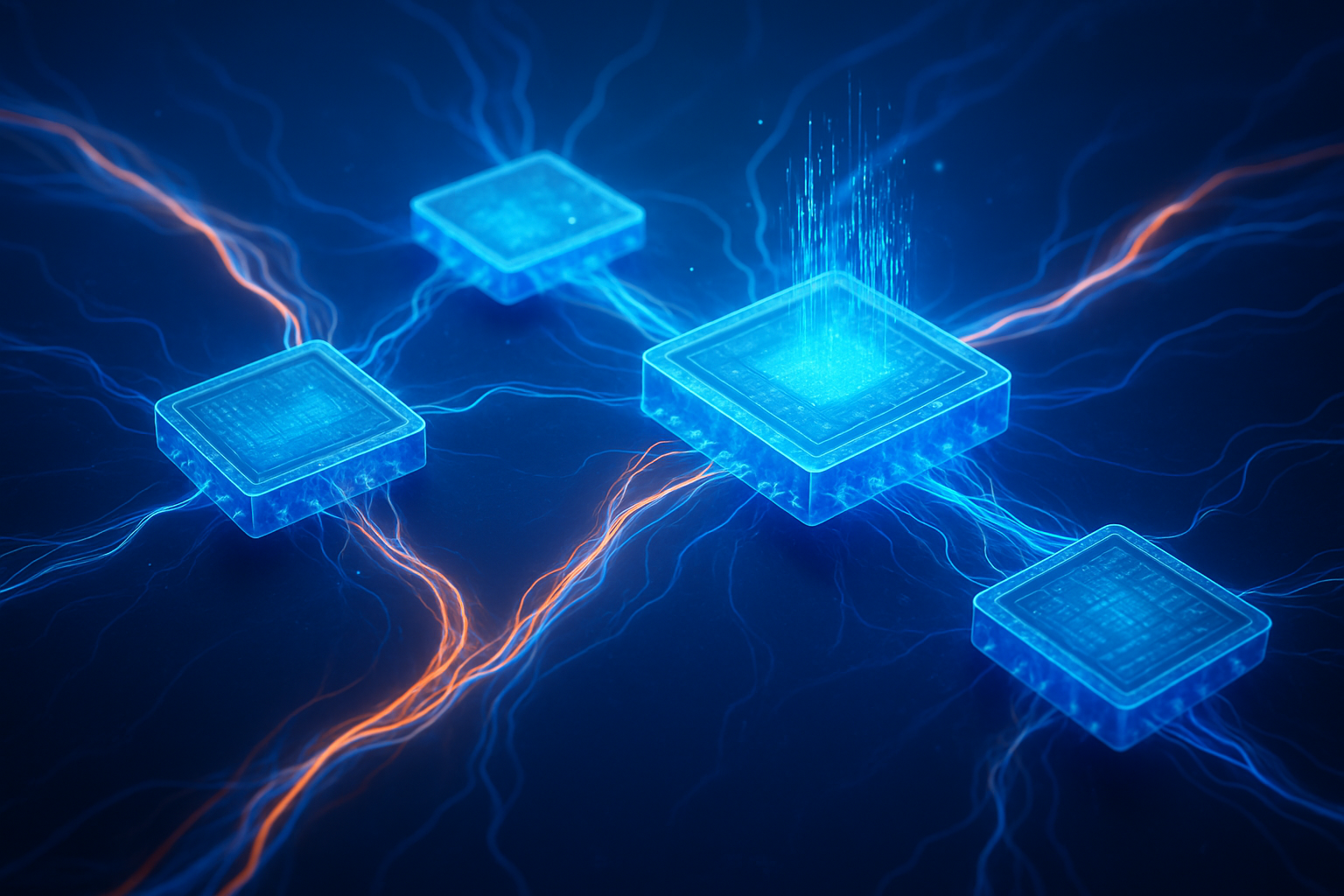The integration of Artificial Intelligence (AI) is fundamentally reshaping the landscape of semiconductor design, offering solutions to increasingly complex challenges and accelerating innovation. This growing trend is further underscored by a landmark strategic partnership between Synopsys (NASDAQ: SNPS) and NVIDIA (NASDAQ: NVDA), announced on December 1, 2025. This alliance signifies a pivotal moment for the industry, promising to revolutionize how chips are designed, simulated, and manufactured, extending its influence across not only the semiconductor industry but also aerospace, automotive, and industrial sectors.
This multi-year collaboration is underpinned by a substantial $2 billion investment by NVIDIA in Synopsys common stock, signaling strong confidence in Synopsys' AI-enabled Electronic Design Automation (EDA) roadmap. The partnership aims to accelerate compute-intensive applications, advance agentic AI engineering, and expand cloud access for critical workflows, ultimately enabling R&D teams to design, simulate, and verify intelligent products with unprecedented precision, speed, and reduced cost.
Technical Revolution: Unpacking the Synopsys-NVIDIA AI Alliance
The strategic partnership between Synopsys and NVIDIA is poised to deliver a technical revolution in design and engineering. At its core, the collaboration focuses on deeply integrating NVIDIA's cutting-edge AI and accelerated computing capabilities with Synopsys' market-leading engineering solutions and EDA tools. This involves a multi-pronged approach to enhance performance and introduce autonomous design capabilities.
A significant advancement is the push towards "Agentic AI Engineering." This involves integrating Synopsys' AgentEngineer™ technology with NVIDIA's comprehensive agentic AI stack, which includes NVIDIA NIM microservices, the NVIDIA NeMo Agent Toolkit software, and NVIDIA Nemotron models. This integration is designed to facilitate autonomous design workflows within EDA and simulation and analysis, moving beyond AI-assisted design to more self-sufficient processes that can dramatically reduce human intervention and accelerate the discovery of novel designs. Furthermore, Synopsys will extensively accelerate and optimize its compute-intensive applications using NVIDIA CUDA-X™ libraries and AI-Physics technologies. This optimization spans critical tasks in chip design, physical verification, molecular simulations, electromagnetic analysis, and optical simulation, promising simulation at unprecedented speed and scale, far surpassing traditional CPU computing.
The partnership projects substantial performance gains across Synopsys' portfolio. For instance, Synopsys.ai Copilot, powered by NVIDIA NIM microservices, is expected to deliver an additional 2x speedup in "time to answers" for engineers, building upon an existing 2x productivity improvement. Synopsys PrimeSim SPICE is projected for a 30x speedup, while computational lithography with Synopsys Proteus is anticipated to achieve up to a 20x speedup using NVIDIA Blackwell architecture. TCAD simulations with Synopsys Sentaurus are expected to be 10x faster, and Synopsys QuantumATK®, utilizing NVIDIA CUDA-X libraries and Blackwell architecture, is slated for up to a 15x improvement for complex atomistic simulations. These advancements represent a significant departure from previous approaches, which were often CPU-bound and lacked the sophisticated AI-driven autonomy now being introduced. The collaboration also emphasizes a deeper integration of electronics and physics, accelerated by AI, to address the increasing complexity of next-generation intelligent systems, a challenge that traditional methodologies struggle to meet efficiently, especially for angstrom-level scaling and complex multi-die/3D chip designs.
Beyond core design, the collaboration will leverage NVIDIA Omniverse and AI-physics tools to enhance the fidelity of digital twins. These highly accurate virtual models will be crucial for virtual testing and system-level modeling across diverse sectors, including semiconductors, automotive, aerospace, and industrial manufacturing. This allows for comprehensive system-level modeling and verification, enabling greater precision and speed in product development. Initial reactions from the AI research community and industry experts have been largely positive, with Synopsys' stock surging post-announcement, indicating strong investor confidence. Analysts view this as a strategic move that solidifies NVIDIA's position as a pivotal enabler of next-generation design processes and strengthens Synopsys' leadership in AI-enabled EDA.
Reshaping the AI Industry: Competitive Dynamics and Strategic Advantages
The strategic partnership between Synopsys and NVIDIA is set to profoundly impact AI companies, tech giants, and startups, reshaping competitive landscapes and potentially disrupting existing products and services. Both Synopsys (NASDAQ: SNPS) and NVIDIA (NASDAQ: NVDA) stand as primary beneficiaries. Synopsys gains a significant capital injection and enhanced capabilities by deeply integrating its EDA tools with NVIDIA's leading AI and accelerated computing platforms, solidifying its market leadership in semiconductor design tools. NVIDIA, in turn, ensures that its hardware is at the core of the chip design process, driving demand for its GPUs and expanding its influence in the crucial EDA market, while also accelerating the design of its own next-generation chips.
The collaboration will also significantly benefit semiconductor design houses, especially those involved in creating complex AI accelerators, by offering faster, more efficient, and more precise design, simulation, and verification processes. This can substantially shorten time-to-market for new AI hardware. Furthermore, R&D teams in industries such as automotive, aerospace, industrial, and healthcare will gain from advanced simulation capabilities and digital twin technologies, enabling them to design and test intelligent products with unprecedented speed and accuracy. AI hardware developers, in general, will have access to more sophisticated design tools, potentially leading to breakthroughs in performance, power efficiency, and cost reduction for specialized AI chips and systems.
However, this alliance also presents competitive implications. Rivals to Synopsys, such as Cadence Design Systems (NASDAQ: CDNS), may face increased pressure to accelerate their own AI integration strategies. While the partnership is non-exclusive, allowing NVIDIA to continue working with Cadence, it signals a potential shift in market dominance. For tech giants like Alphabet (NASDAQ: GOOGL), Amazon (NASDAQ: AMZN), and Microsoft (NASDAQ: MSFT) that are developing their own custom AI silicon (e.g., TPUs, AWS Inferentia/Trainium, Azure Maia), this partnership could accelerate the design capabilities of their competitors or make it easier for smaller players to bring competitive hardware to market. They may need to deepen their own EDA partnerships or invest more heavily in internal toolchains to keep pace. The integration of agentic AI and accelerated computing is expected to transform traditionally CPU-bound engineering tasks, disrupting existing, slower EDA workflows and potentially rendering less automated or less GPU-optimized design services less competitive.
Strategically, Synopsys strengthens its position as a critical enabler of AI-powered chip design and system-level solutions, bridging the gap between semiconductor design and system-level simulation, especially with its recent acquisition of Ansys (NASDAQ: ANSS). NVIDIA further solidifies its control over the AI ecosystem, not just as a hardware provider but also as a key player in the foundational software and tools used to design that hardware. This strategic investment is a clear example of NVIDIA "designing the market it wants" and underwriting the AI boom. The non-exclusive nature of the partnership offers strategic flexibility, allowing both companies to maintain relationships with other industry players, thereby expanding their reach and influence without being limited to a single ecosystem.
Broader Significance: AI's Architectural Leap and Market Dynamics
The Synopsys (NASDAQ: SNPS) and NVIDIA (NASDAQ: NVDA) partnership represents a profound shift in the broader AI landscape, signaling a new era where AI is not just a consumer of advanced chips but an indispensable architect and accelerator of their creation. This collaboration is a direct response to the escalating complexity and cost of developing next-generation intelligent systems, particularly at angstrom-level scaling, firmly embedding itself within the burgeoning "AI Supercycle."
One of the most significant aspects of this alliance is the move towards "Agentic AI engineering." This elevates AI's role from merely optimizing existing processes to autonomously tackling complex design and engineering tasks, paving the way for unprecedented innovation. By integrating Synopsys' AgentEngineer technology with NVIDIA's agentic AI stack, the partnership aims to create dynamic, self-learning systems capable of operating within complex engineering contexts. This fundamentally changes how engineers interact with design processes, promising enhanced productivity and design quality. The dominance of GPU-accelerated computing, spearheaded by NVIDIA's CUDA-X, is further cemented, enabling simulation at speeds and scales previously unattainable with traditional CPU computing and expanding Synopsys' already broad GPU-accelerated software portfolio.
The collaboration will have profound impacts across multiple industries. It promises dramatic speedups in engineering workflows, with examples like Ansys Fluent fluid simulation software achieving a 500x speedup and Synopsys QuantumATK seeing up to a 15x improvement in time to results for atomistic simulations. These advancements can reduce tasks that once took weeks to mere minutes or hours, thereby accelerating innovation and time-to-market for new products. The partnership's reach extends beyond semiconductors, opening new market opportunities in aerospace, automotive, and industrial sectors, where complex simulations and designs are critical.
However, this strategic move also raises potential concerns regarding market dynamics. NVIDIA's $2 billion investment in Synopsys, combined with its numerous other partnerships and investments in the AI ecosystem, has led to discussions about "circular deals" and increasing market concentration within the AI industry. While the Synopsys-NVIDIA partnership itself is non-exclusive, the broader regulatory environment is increasingly scrutinizing major tech collaborations and mergers. Synopsys' separate $35 billion acquisition of Ansys (NASDAQ: ANSS), for example, faced significant antitrust reviews from the Federal Trade Commission (FTC), the European Union, and China, requiring divestitures to proceed. This indicates a keen eye from regulators on consolidation within the chip design software and simulation markets, particularly in light of geopolitical tensions impacting the tech sector.
This partnership is a leap forward from previous AI milestones, signaling a shift from "optimization AI" to "Agentic AI." It elevates AI's role from an assistive tool to a foundational design force, akin to or exceeding previous industrial revolutions driven by new technologies. It "reimagines engineering," pushing the boundaries of what's possible in complex system design.
The Horizon: Future Developments in AI-Driven Design
The Synopsys (NASDAQ: SNPS) and NVIDIA (NASDAQ: NVDA) strategic partnership, forged in late 2025, sets the stage for a transformative future in engineering and design. In the near term, the immediate focus will be on the seamless integration and optimization of Synopsys' compute-intensive applications with NVIDIA's accelerated computing platforms and AI technologies. This includes a rapid rollout of GPU-accelerated versions of tools like PrimeSim SPICE, Proteus for computational lithography, and Sentaurus TCAD, promising substantial speedups that will impact design cycles almost immediately. The advancement of agentic AI workflows, integrating Synopsys AgentEngineer™ with NVIDIA's agentic AI stack, will also be a key near-term objective, aiming to streamline and automate laborious engineering steps. Furthermore, expanded cloud access for these GPU-accelerated solutions and joint market initiatives will be crucial for widespread adoption.
Looking further ahead, the long-term implications are even more profound. The partnership is expected to fundamentally revolutionize how intelligent products are conceived, designed, and developed across a wide array of industries. A key long-term goal is the widespread creation of fully functional digital twins within the computer, allowing for comprehensive simulation and verification of entire systems, from atomic-scale components to complete intelligent products. This capability will be essential for developing next-generation intelligent systems, which increasingly demand a deeper integration of electronics and physics with advanced AI and computing capabilities. The alliance will also play a critical role in supporting the proliferation of multi-die chip designs, with Synopsys predicting that by 2025, 50% of new high-performance computing (HPC) chip designs will utilize 2.5D or 3D multi-die architectures, facilitated by advancements in design tools and interconnect standards.
Despite the promising outlook, several challenges need to be addressed. The inherent complexity and escalating costs of R&D, coupled with intense time-to-market pressures, mean that the integrated solutions must consistently deliver on their promise of efficiency and precision. The non-exclusive nature of the partnership, while offering flexibility, also means both companies must continuously innovate to maintain their competitive edge against other industry collaborations. Keeping pace with the rapid evolution of AI technology and navigating geopolitical tensions that could disrupt supply chains or limit scalability will also be critical. Some analysts also express concerns about "circular deals" and the potential for an "AI bubble" within the ecosystem, suggesting a need for careful market monitoring.
Experts largely predict that this partnership will solidify NVIDIA's (NASDAQ: NVDA) position as a foundational enabler of next-generation design processes, extending its influence beyond hardware into the core AI software ecosystem. The $2 billion investment underscores NVIDIA's strong confidence in the long-term value of AI-driven semiconductor design and engineering software. NVIDIA CEO Jensen Huang's vision to "reimagine engineering and design" through this alliance suggests a future where AI empowers engineers to invent "extraordinary products" with unprecedented speed and precision, setting new benchmarks for innovation across the tech industry.
A New Chapter in AI-Driven Innovation: The Synopsys-NVIDIA Synthesis
The strategic partnership between Synopsys (NASDAQ: SNPS) and NVIDIA (NASDAQ: NVDA), cemented by a substantial $2 billion investment from NVIDIA, marks a pivotal moment in the ongoing evolution of artificial intelligence and its integration into core technological infrastructure. This multi-year collaboration is not merely a business deal; it represents a profound synthesis of AI and accelerated computing with the intricate world of electronic design automation (EDA) and engineering solutions. The key takeaway is a concerted effort to tackle the escalating complexity and cost of developing next-generation intelligent systems, promising to revolutionize how chips and advanced products are designed, simulated, and verified.
This development holds immense significance in AI history, signaling a shift where AI transitions from an assistive tool to a foundational architect of innovation. NVIDIA's strategic software push, embedding its powerful GPU acceleration and AI platforms deeply within Synopsys' leading EDA tools, ensures that AI is not just consuming advanced chips but actively shaping their very creation. This move solidifies NVIDIA's position not only as a hardware powerhouse but also as a critical enabler of next-generation design processes, while validating Synopsys' AI-enabled EDA roadmap. The emphasis on "agentic AI engineering" is particularly noteworthy, aiming to automate complex design tasks and potentially usher in an era of autonomous chip design, drastically reducing development cycles and fostering unprecedented innovation.
The long-term impact is expected to be transformative, accelerating innovation cycles across semiconductors, automotive, aerospace, and other advanced manufacturing sectors. AI will become more deeply embedded throughout the entire product development lifecycle, leading to strengthened market positions for both NVIDIA and Synopsys and potentially setting new industry standards for AI-driven design tools. The proliferation of highly accurate digital twins, enabled by NVIDIA Omniverse and AI-physics, will revolutionize virtual testing and system-level modeling, allowing for greater precision and speed in product development across diverse industries.
In the coming weeks and months, industry observers will be keenly watching for the commercial rollout of the integrated solutions. Specific product announcements and updates from Synopsys, demonstrating the tangible integration of NVIDIA's CUDA, AI, and Omniverse technologies, will provide concrete examples of the partnership's early fruits. The market adoption rates and customer feedback will be crucial indicators of immediate success. Given the non-exclusive nature of the partnership, the reactions and adaptations of other players in the EDA ecosystem, such as Cadence Design Systems (NASDAQ: CDNS), will also be a key area of focus. Finally, the broader financial performance of both companies and any further regulatory scrutiny regarding NVIDIA's growing influence in the tech industry will continue to be closely monitored as this formidable alliance reshapes the future of AI-driven engineering.
This content is intended for informational purposes only and represents analysis of current AI developments.
TokenRing AI delivers enterprise-grade solutions for multi-agent AI workflow orchestration, AI-powered development tools, and seamless remote collaboration platforms.
For more information, visit https://www.tokenring.ai/.






